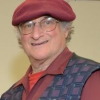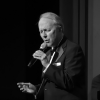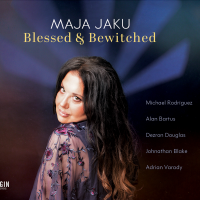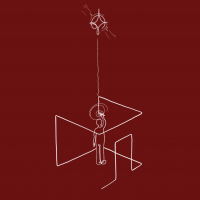Home » Jazz Musicians » Mark Murphy
Mark Murphy
The following is based on the book This is Hip: the Life of Mark Murphy by Peter Jones (Equinox Publishing, 2018). All rights reserved.
In the opinion of many, Mark Murphy was the greatest jazz singer who ever lived.
Quite a statement, but one that can be made to stand up pretty well in court. There have, of course, been more successful jazz singers; certainly more popular jazz singers. But not one of them has possessed the sheer range of abilities that Murphy was blessed with. He had a natural “instrument” at his disposal, a rich, masculine tone that could shape any jazz standard as beautifully as you were ever likely to hear it. When that great arbiter of musical taste Alec Wilder, author of American Popular Song, heard Murphy for the first time, he declared him to be “one of the very few great singers I have ever heard.”
Murphy perfected all the important styles of jazz. Early in his career, he learned how to swing, as you can hear on his version of "Fascinating Rhythm", the opening track on his first album Meet Mark Murphy (Decca, 1956). As the tune fades out, he launches into a scat solo: that’s another skill he mastered (although he often overdid it later in his career). With That’s How I Love The Blues! (Riverside, 1963) he revealed his natural affinity for the kind of material popularised by Billy Eckstine and Joe Williams, treating the blues with a relaxed familiarity far removed from the efforts of those white performers through the decades who have tried a little too hard to emulate their black progenitors. That feeling was just as strong 40 years later on his Joe Williams tribute album Memories of You (HighNote, 2003). Discovering Brazilian music in the late 1950s, Mark Murphy proved himself just as adept at latin styles, recording many tracks during his career, from a couple of excellent contributions to the compilation album Everybody’s Doin’ the Bossa Nova (Riverside, 1962), to Brazil Song (Muse, 1983) to The Latin Porter (GoJazz, 2000). He was also a peerless interpreter of ballads. As he grew older, the ballads grew deeper and darker, until on the late Verve masterpieces Once to Every Heart (2005) and Love is What Stays (2007), which he recorded in his seventies, he almost seems to be singing from beyond the grave. One such tune - the haunting, crepuscular "Our Game" - was played repeatedly on London’s Jazz FM in the days following Mark’s death in 2015.
Read moreTags
Mark Murphy: An Essential Top Ten Albums

by Peter Jones
Revered by jazz singers the world over, Mark Murphy is barely known to the general public--which is curious, since he enjoyed a recording career that lasted more than half a century, made 48 albums in his lifetime, and played thousands of gigs with hundreds of musicians from Norway to Australia. A notoriously mercurial and secretive character, he was gay at a time when homosexuality was not merely frowned upon but illegal. He was a white man when many thought that ...
Continue ReadingThis Is Hip - The Life of Mark Murphy

by Angelo Leonardi
This is Hip —The Life of Mark Murphy Peter Jones 247 Pages ISBN: # 978-1-78179-473-9 Equinox Publishing 2018 Non è casuale che questa bella biografia sul più eclettico jazz singer bianco sia opera di un inglese e venga pubblicata in Gran Bretagna. Il pubblico del Regno Unito ha supportato Mark negli anni della Swinging London (i più difficili della sua carriera negli Stati Uniti) e l'ha accolto con entusiasmo alla fine degli Ottanta, ...
Continue ReadingL'ultimo hipster. La vita e la musica di Mark Murphy

by Angelo Leonardi
Non trovate accenni a Mark Murphy nelle più recenti storie del jazz, neanche il nome. Una lacuna che appare inspiegabile (a differenza di Frank Sinatra, Mel Tormè e Tony Bennett) che si giustifica solo col ritardo a collocare il cantante di Syracuse in una prospettiva storica. Eppure già prima della sua scomparsa -il 22 ottobre 2015 all'età di 83 anni--autorevoli critici e musicisti hanno considerato Murphy tra i massimi jazz vocalist moderni, il più importante tra i ...
Continue ReadingMark Murphy: Live in Italy 2001

by Angelo Leonardi
Quest'inedito concerto di Mark Murphy del 2001 è un documento prezioso che ci ricorda uno dei massimi vocalist della storia del jazz, il più eclettico e creativo della sua generazione. Incrementa il valore del compact la presenza di Marco Tamburini--allora 42enne--in uno smagliante quartetto con Marco Piacentini, Piero Leveratto e Marco Tonin. Il 18 maggio 2001 il cantante di Syracuse fu invitato a Brescia ad aprire la prima “Rassegna Jazz e Letteratura" quale grande interprete del vocalese ...
Continue ReadingMark Murphy: Live in Athens, Greece

by Dan Bilawsky
No figure in jazz personified hip the way that the late Mark Murphy did. For more than half a century he taught the world what it meant to be a true artist, pushing boundaries, walking the tightrope, and going where he pleased. He had it all--wit, charm, guile, good taste, a pure improviser's spirit, a flexible and powerful voice--and he willingly shared it. Murphy remained current and above the trend-based fray(s) for most of his career, starting ...
Continue ReadingMark Murphy: A Beautiful Friendship: Remembering Shirley Horn

by Bruce Lindsay
In his time, vocalist Mark Murphy has been described as hip, cool, swinging, fearless, gruff, and eccentric (among other things). Some-- but most definitely not all--of these terms could also be applied to Shirley Horn. So it's fitting that Murphy should pay tribute to his compatriot, as he does on A Beautiful Friendship: Remembering Shirley Horn, even though Murphy acknowledges that the two vocal legends didn't know each other too well.This four-track vinyl EP (accompanied by a download ...
Continue ReadingMark Murphy: Inside the Mystery

by Suzanne Lorge
Beyond its stylistic differentiators, jazz contains what vocalist Mark Murphy calls “a wonderful mystery," a mystery that was fostered in small, regional clubs around the US during the '30s-40s, when Murphy was developing the distinctive vocal style that launched his decades-long career. “I've seen this mysterious quality of jazz set rooms on fire," Murphy attests. “[Rooms] where nothing was going on until the band shuffled up and this musical rhythmic thing would happen right there on the spot." ...
Continue ReadingJazz Musician of the Day: Mark Murphy

Source:
Michael Ricci
All About Jazz is celebrating Mark Murphy's birthday today!
The following is based on the book This is Hip: the Life of Mark Murphy by Peter Jones (Equinox Publishing, 2018). All rights reserved. In the opinion of many, Mark Murphy was the greatest jazz singer who ever lived. Quite a statement, but one that can be made to stand up pretty well in court. There have, of course, been more successful jazz singers; certainly more popular jazz singers. But not ...
read more
Mark Murphy, 1956-1962 (Pt. 1)

Source:
JazzWax by Marc Myers
Jackie Paris and Mark Murphy had a lot in common. Both were hip club singers with bop flexibility and a natural sense of swing. But where Paris took Charlie Parker as his inspiration, Murphy was more enamored of Miles Davis. Murphy, of course, began his recording career nearly 10 years after Paris, and while Paris had his best years at the start of his career, Murphy didn't become a household name in jazz circles until 16 years after his his ...
read more
Jazz Musician of the Day: Mark Murphy

Source:
Michael Ricci
All About Jazz is celebrating Mark Murphy's birthday today!
The following is based on the book This is Hip: the Life of Mark Murphy by Peter Jones (Equinox Publishing, 2018). All rights reserved. In the opinion of many, Mark Murphy was the greatest jazz singer who ever lived. Quite a statement, but one that can be made to stand up pretty well in court. There have, of course, been more successful jazz singers; certainly more popular jazz singers. But not ...
read more
Jazz Musician of the Day: Mark Murphy

Source:
Michael Ricci
All About Jazz is celebrating Mark Murphy's birthday today!
The following is based on the book This is Hip: the Life of Mark Murphy by Peter Jones (Equinox Publishing, 2018). All rights reserved. In the opinion of many, Mark Murphy was the greatest jazz singer who ever lived. Quite a statement, but one that can be made to stand up pretty well in court. There have, of course, been more successful jazz singers; certainly more popular jazz singers. But not ...
read more
Jazz Musician of the Day: Mark Murphy

Source:
Michael Ricci
All About Jazz is celebrating Mark Murphy's birthday today!
Mark Murphy is one of the world's greatest — and hippest — jazz vocalists performing today. His coterie of fans includes tap dancer Gregory Hines, who spontaneously jumped up on stage at Mark's Las Vegas engagement in 1995 to join him for an impromptu duet. Legendary composer Alec Wilder said of Mark, 'I was quite literally amazed. Mark's musicianship, range, intonation, diction, inventiveness and incredible rhythmic sense are all of a ...
read more
Jazz Musician of the Day: Mark Murphy

Source:
Michael Ricci
All About Jazz is celebrating Mark Murphy's birthday today!
Mark Murphy is one of the world\'s greatest — and hippest — jazz vocalists performing today. His coterie of fans includes tap dancer Gregory Hines, who spontaneously jumped up on stage at Mark\'s Las Vegas engagement in 1995 to join him for an impromptu duet. Legendary composer Alec Wilder said of Mark, \'I was quite literally amazed. Mark\'s musicianship, range, intonation, diction... Read more.
Place our Musician of the Day widget ...
read more
Jazz Musician of the Day: Mark Murphy

Source:
Michael Ricci
All About Jazz is celebrating Mark Murphy's birthday today!
Mark Murphy is one of the world\'s greatest — and hippest — jazz vocalists performing today. His coterie of fans includes tap dancer Gregory Hines, who spontaneously jumped up on stage at Mark\'s Las Vegas engagement in 1995 to join him for an impromptu duet. Legendary composer Alec Wilder said of Mark, \'I was quite literally amazed. Mark\'s musicianship, range, intonation, diction... Read more.
Place our Musician of the Day widget ...
read more
Jazz Musician of the Day: Mark Murphy

Source:
Michael Ricci
All About Jazz is celebrating Mark Murphy's birthday today!
Mark Murphy is one of the world\'s greatest — and hippest — jazz vocalists performing today. His coterie of fans includes tap dancer Gregory Hines, who spontaneously jumped up on stage at Mark\'s Las Vegas engagement in 1995 to join him for an impromptu duet. Legendary composer Alec Wilder said of Mark, \'I was quite literally amazed. Mark\'s musicianship, range, intonation, diction... Read more.
Place our Musician of the Day widget ...
read more
Jazz Musician of the Day: Mark Murphy

Source:
Michael Ricci
All About Jazz is celebrating Mark Murphy's birthday today!
Mark Murphy is one of the world\'s greatest — and hippest — jazz vocalists performing today. His coterie of fans includes tap dancer Gregory Hines, who spontaneously jumped up on stage at Mark\'s Las Vegas engagement in 1995 to join him for an impromptu duet. Legendary composer Alec Wilder said of Mark, \'I was quite literally amazed. Mark\'s musicianship, range, intonation, diction... Read more.
Place our Musician of the Day widget ...
read more
Mark Murphy, 1932-1915

Source:
Rifftides by Doug Ramsey
Mark Murphy died last night in his sleep following a long illness. He was 83. Murphy’s eagerness to take artistic chances combined with his innate musicianship to make him one of the most interesting singers in jazz. He died at the Lillian Booth Actors Home in Englewood, New Jersey. Born in Fulton, New York, in 1932, He sang from the age of four and studied acting at nearby Syracuse University. Following graduation in 1953, he played piano and sang in ...
read more






































































